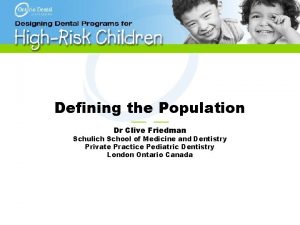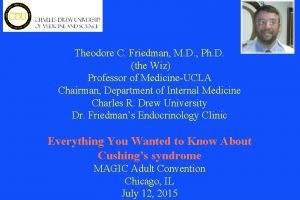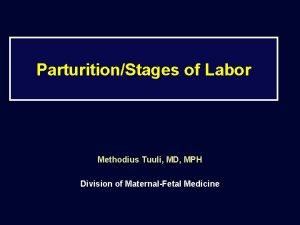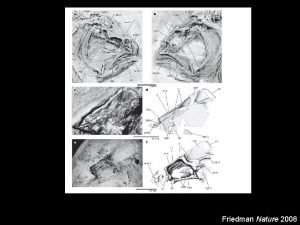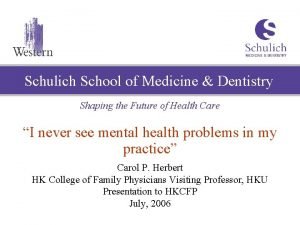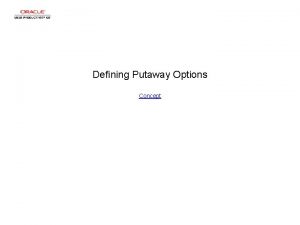Defining the Population Dr Clive Friedman Schulich School






















- Slides: 22

Defining the Population —— —— Dr Clive Friedman Schulich School of Medicine and Dentistry Private Practice Pediatric Dentistry London Ontario Canada

Defining the Population What is MEANT BY HIGH RISK

OTTAWA CHARTER Peace Conditions for Health A stable eco-system Shelter Food Social justice, and equity Education Income Sustainable resources

Caries is a transmissible bacterial infection and a multifactorial disease that reflects change in one or more significant factors in the total oral environment. (NIH Consensus Conference 2001) Diagnosis involves recognition of these changes rather than simply noting cavities

How Serious is This Problem • Most Common Disease of Childhood (Kappel R 2000) • Outpatient general anesthesia -pediatric surgery - dental highest usage Iadr 2008

Dental Caries is one of the most common diseases among 5 – 17 year olds Note: Data included decayed or filled primary and or decayed filled or missing permanent teeth. Asthma, chronic bronchitis and hay fever based upon household respondent about the sampled 5 – 17 year old Source NCHS 1996 Oral Health in America: A Report of the Surgeon General DHHS 2000

The Caries Imbalance Protective factors Risk Factors Bad Bacteria Absence of saliva Dietary habits Disease Indicators White spots Restorations<3 yrs Enamel lesions Cavities /dentin Drinks Self Help Skills Regurgitationmeds Family History Aberrant Anatomy Med History Immune systems Behaviors -SES Saliva &Sealants Antibacterials Fluoride Effective Diet No Caries Progression From J Featherstone

Risk Factors Age 1 -3 Modifying - Factors that have an indirect impact on the biofilm 5 -7 12 -15 Active - SALIVA DIET FLUORIDE

Erosion MORE THAN JUST DIET Acidic Saliva Low Buffering Capacity GERD

Obesity Trends Among Canadian and U. S. Adults, 1994 No Data <10% 10%-14% 15 -19% 20% Mokdad AH, et al. J Am Med Assoc 1999; 282: 16. Katzmarzyk PT. Can Med Assoc J 2002; 166: 1039 -1040.

Obesity Trends Among Canadian and U. S. Adults, 2003 (BMI > 30 ) No Data <10% 10%-14% 15 -19% 20% • 1/3 of Canadian children overweight/ obese • 70% of obese children will grow-up to become obeseadults • Approx 70% of males and 50% females will be overweight or obese by 2020 Canadian Paediatric Society 2002; He & Sutton, 2004; Le Petit, 2005; Tremblay, Katzmarzyk, & Willms, 2002

Early Childhood Caries - Prevalence < 4 yrs Data Collected using DMFT not ICDAS 4%Quebec convenience sample of 301 12 -24 month infants Veronneau etal 1% USA representative sample of 654 12 -23 mo infants Kasteet etal 1996 17% USA sample of 1627 2 -4 yr old children Kaste et al 1996 30% Whole Cree population age 12 -24 months Quebec Veronneau et al 2002 55% Whole inuit population age 24 -36 months in NWT Albert et al 1998 87 % representative sample of 470 24 -48 mo old Ojibway (N Ontario) infants Lawrence 2008 53% representative sample 408 children First Nations - DEFT of 4. 2 80% of caries in 31% of population in Manitoba Schroth etal 2005

Early Childhood Caries is a risk factor future caries and is a good indicator of future caries experience *Al-Shalan TA, et al. Primary incisor decay before age 4 as a risk factor future dental caries. Pediatr Dent. 19(1): 37 -41, 1997 *O'Sullivan DM, Tinanoff, N, The association of early dental caries patterns with caries incidence in preschool children. , J Public Health Dent 56(2): 81 -3, 1996 *Kaste, LM, et al. The assessment of nursing caries and its relationship to high caries in the permanent dentition. J Public Health Dent. 52(2): 64 -8, 1992 *Almeida, Al et al. Future caries susceptibility in children with Early Childhood Caries following treatment under General Anesthesia. Pediatr Dent 22 (4) 302 306, 2000 BY THIS TIME IT IS TOO LATE

Shifts in Ethnic/SES Distribution 80% of caries in 20 -25% of population. • disproportionately more caries found in lower SES groups. • disproportionately more caries found in minority groups Kaste, LM et al, An evaluation of NHANES III estimates of early childhood caries J Public Health Dent 59(3): 198 -200, 1999 O’Sullivan DM, Tinanoff, N: Social and Biological factors contributing to caries of the maxillary anterior teeth. Pediatr Dent 15: 41 -44, 1993

How Serious is This Problem - Prevalence Studies - First Nations - Endemic - 50 -95% Milnes, AR JPub. Health. Dent 56: 38 -50 1996 Schroth Smith, Whalen, Lekic, Moffatt cda Sept 2005 vol 71, #8 Schroth Moore Brothwell - cda Sept 2005 vol 71, #8

Defining the Problem -Prevalence Local Screening Program - London Ontario 46 % of children of entire elementary school district surveyed - 2002 13 % (1 in 8) of all JK and K had untreated visible decay 4. 5% required urgent care Of JK children who had experienced decay - 49% - did not have needs met Untreated - or children needing treatment located in specific school districts Families least likely to afford treatment have highest levels of decay Current Data 5 yr olds from 05 -06 11% needed dental work - 67% observed decay free

How Serious is the Problem AMYGDALA An “alarm centre” for evocative stimuli - key component in neuro networks involved with fear, attachment, and early memory.

How Serious is This Problem Parents unaware until child in pain. Cavities damage a child’s: - School Performance - Ability to eat and thrive - Weigh less - Sense of self Worth - Long term well being Low 1999 Acs et al 1999

Pediatric Dentists in Ontario

GA Access -Waiting Times

Summary DENTAL INFECTIOUS DISEASE - CARIES IS CLEARLY A SERIOUS PROBLEM Risk Factors ENVIRONMENT - OBESITY - DIET - SES - EDUCATION Cariogenic Bacteria SALIVA - FLUORIDE - BIOFILM Need IMPROVED DIAGNOSTIC TOOLS EARLY INTERVENTION PROGRAMS

“The past throws stones on the Future And all of them fall on the Present “ Yehuda Amichai Author Future of our country investing in children’s health is essential to our growth as a Nation ~ Leitch, 2008
 Stephen friedman schulich
Stephen friedman schulich Dr clive friedman
Dr clive friedman Schulich uav
Schulich uav Non-defining relative clauses
Non-defining relative clauses Relative clauses defining and non defining
Relative clauses defining and non defining Diferencia entre defining y non defining
Diferencia entre defining y non defining Defining and non defining relative clauses in telugu
Defining and non defining relative clauses in telugu Non defining relative clauses
Non defining relative clauses Defining non defining relative clauses
Defining non defining relative clauses Chapter 4 population ecology worksheet answer key
Chapter 4 population ecology worksheet answer key Section 1 population dynamics
Section 1 population dynamics Population ecology section 1 population dynamics
Population ecology section 1 population dynamics Population ecology section 1 population dynamics answer key
Population ecology section 1 population dynamics answer key Contoh soal uji kruskal wallis spss
Contoh soal uji kruskal wallis spss Theodore friedman md
Theodore friedman md Flat world theory friedman
Flat world theory friedman Richard j friedman, md
Richard j friedman, md Friedman palate position
Friedman palate position Normal labour ppt
Normal labour ppt Teori milton friedman
Teori milton friedman When do we use friedman test
When do we use friedman test Mv = py
Mv = py Monetarism
Monetarism

